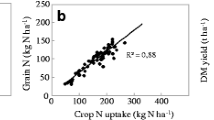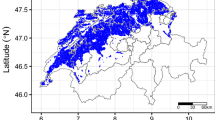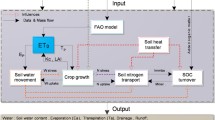Abstract
The Water and Nitrogen Management model (WNMM) was applied to simulate N2O emissions from a rain-fed wheat cropping system on a loam-textured soil for two treatments, conventional cultivation with residue burn (CC + BURN + N) and direct drill with residue retention (DD + RET + N), at Rutherglen in southeastern Australia from January 2004 to March 2005. Both treatments received the same amount of nitrogen (N) fertiliser. The WNMM satisfactorily simulated the soil water content, mineral N contents and N2O emissions from the soil, as compared with the field observations for both treatments. The simulated nitrification-induced N2O emissions accounted for 45% and 34% of total N2O emissions for the treatments CC + BURN + N and DD + RET + N, respectively. The calibrated WNMM was used to simulate N2O emissions from this soil using historic daily weather data from 1968 to 2004 and applying seven scenarios of fertiliser N application. Correlation analysis found that the annual N2O emissions for this rain-fed wheat cropping system were significantly correlated to the annual average of daily maximum air temperature (r = 0.51 for CC + BURN + N and 0.56 for DD + RET + N), annual rainfall (r = −0.56 for CC + BURN + N and −0.59 for DD + RET + N) and fertiliser N application rate (r = 0.43 for CC + BURN + N and 0.31 for DD + RET + N). Based on the 37-year historic simulations, multivariate regression models for estimating annual N2O emissions were developed to account for climatic variation, and explained about 50% of variations of annual N2O emissions estimated by WNMM.





Similar content being viewed by others
References
Barker-Reid F, Gates WP, Wilson K, Baigent R, Galbally IE, Meyer CP, Weeks IA, Eckard RJ (2005) Soil nitrous oxide emissions from rain-fed wheat in SE Australia. In Fourth International Symposium on Non-CO2 Greenhouse gases (NCGG-4) Science, Control, Policy and Implementation. Mill Press, Utrecht, The Netherlands, pp. 8
Bouwman AF (1996) Direct emission of nitrous oxide from agricultural soils. Nutr Cycl Agroecosyst 46:53–70
Bouwman AF, Boumans LJM, Batjes NH (2002) Modeling global annual N2O and NO emissions from fertilized fields. Glob Biogeochem Cycles 16:1080–1088
Brown L, Syed B, Jarvis SC, Sneath RW, Phillips VR, Goulding KWT, Li C (2002) Development and application of a mechanistic model to estimate emission of nitrous oxide from UK agriculture. Atmos Environ 36:917–928
Chatskikh D, Olesen J, Berntsen J, Regina K, Yamulki S (2005) Simulation of effects of soils, climate and management on N2O emission from grasslands. Biogeochemistry 76:395–419
Chen D, Li Y, Grace P, Mosier AR (2008) N2O emissions from agricultural lands: a synthesis of simulation approaches. Plant Soil (in this issue) DOI 10.1007/s11104-008-9634-0
Clayton H, Arah JRM, Smith KA (1994) Measurement of nitrous oxide emission from fertilised grassland using closed chambers. J Geophys Res Atmos 99:16599–16607
Corre MD, Pennock DJ, Van Kessel C, Elliott DK (1999) Estimation of annual nitrous oxide emissions from a transitional grassland-forest region in Saskatchewan, Canada. Biogeochemistry 44:29–49
Dobbie KE, McTaggart IP, Smith KA (1999) Nitrous oxide emissions from intensive agricultural systems: Variations between crops and seasons, key driving variables, and mean emission factors. J Geophys Res Atmos 104:26891–26899
Dobbie KE, Smith KA (2003) Nitrous oxide emission factors for agricultural soils in Great Britain: the impact of soil water-filled pore space and other controlling variables. Glob Chang Biol 9:204–218
FAO/IFA (2001) Global estimates of gaseous emissions of NH3, NO and N2O from agricultural land. Food and Agriculture Organization of the United Nations (FAO)/International Fertilizer Industry Association (IFA), Rome, pp. 106 (available from http://www.fertilizer.org/ifa)
Freibauer A (2003) Regionalised inventory of biogenic greenhouse gas emissions from European agriculture. Eur J Agron 19:135–160
Granli T, Bøckman OC (1994) Nitrous oxide from agriculture. Nor J Agric Sci 12:7–127
Imhof M, Rampant P, Lourey R, Martin J, Hall R (1996) Major agricultural soils of the institute for integrated agricultural development-Rutherglen. Unpublished report. Department of Natural Resources and Environment. http://www.dpi.vic.gov.au/dpi/vro/neregn.nsf/pages/ne_soil_detailed_rutherglen
IPCC (Intergovernmental Panel On Climate Change) (1997) Greenhouse gas emissions from agricultural soils. In Greenhouse Gas Inventory Reference Manual; Revised 1996 IPCC Guidelines for National Greenhouse Gas Inventories, Vol.3, Section 4.5 Agriculture. Ed. J T Houghton et al. IPCC/OECD/IEA. UK Meteorological Office, Bracknell, UK
IPCC (2006) Greenhouse Gas Emissions from Agriculture, Forestry and Other Land Use. In: Egglaston HS, Buendia L, Miwa K, Ngara T, Tanabe K (eds) 2006 IPCC Guidelines for National Greenhouse Gas Inventories. vol. 4. IGES, Japan
Li C (2000) Modeling trace gas emissions from agricultural ecosystems. Nutr Cycl Agroecosyst 58:259–276
Li Y, Chen DL, White RE, Zhang JB, Li BG, Zhang YM, Huang YF, Edis R (2007) A spatially referenced Water and Nitrogen Management Model (WNMM) for (irrigated) intensive cropping systems in the North China Plain. Ecol Model 203:395–423
Li Y, Chen DL, Zhang YM, Edis R, Ding H (2005) Comparison of three modelling approaches for simulating denitrification and nitrous oxide emissions from loam-textured arable soils. Glob Biogeochem Cycles 19:1–15
Li C, Frolking S, Frolking TA (1992) A model of nitrous oxide evolution from soil driven by rainfall events: I. Model structure and sensitivity. J Geophys Res 97:9759–9776
Li C, Narayanan V, Harriss RC (1996) Model estimates of nitrous oxide emissions from agricultural lands in the United States. Glob Biogeochem Cycles 10:297–306
Li C, Zhuang Y, Cao M, Crill P, Dai Z, Frolking S, Moore B III, Salas W, Song W, Wang X (2001) Comparing a process-based agro-ecosystem model to the IPCC methodology for developing a national inventory of N2O emissions from arable lands in China. Nutr Cycl Agroecosyst 60:159–175
Lilly A, Ball BC, McTaggart IP, Horne PL (2003) Spatial and temporal scaling of nitrous oxide emissions from the field to the regional scale in Scotland. Nutr Cycl Agroecosyst 66:241–257
Meyer CP, Galbally IE, Wang YP, Weeks IA, Jamie IM, Griffith DWT (2001) Two automatic chamber techniques for measuring soil–atmosphere exchanges of trace gases and results of their use in the oasis field experiment. Aspendale: CSIRO Atmospheric Research. (CSIRO Atmospheric Research technical paper: no. 51). 30 pp
Mosier AR (1994) Nitrous oxide emissions from agricultural soils. Fertil Res 37:191–200
Mosier AR, Duxbury JM, Freney JR, Heinemeyer O, Minami K (1996) Nitrous oxide emission from agricultural fields: assessment, measurement and mitigation. Plant Soil 181:95–108
Mosier AR, Kroeze C, Nevison C, Oenema O, Seitzinger S, van Cleamput O (1998) Closing the global N2O budget: nitrous oxide emissions through the agricultural nitrogen cycle. Nutr Cycl Agroecosyst 52:225–248
Parton WJ, Holland EA, Del Grosso SJ, Hartman MD, Martin RE, Mosier AR, Ojima DS, Schimel DS (2001) Generalized model for NO x and N2O emissions from soils. J Geophys Res 106:17403–17419
Page CM, Jones RN (2001) OzClim: the development of a climate scenario generator for Australia. In: Ghassemi F (ed) MODSIM 2001: International Congress on Modelling and Simulation: proceedings, Australian National University. Modelling and Simulation Society of Australia and New Zealand, Canberra, Australia, pp 667–671
Plant (1999) Effects of land use on regional nitrous oxide emissions in the humid tropics of Costa Rica. Extrapolating fluxes from field to regional scales. Wagenningen Agricultural University Dissertation no. 2575
Smith WN, Grant B, Desjardins RL, Lemke R, Li C (2004) Estimates of the interannual variations of N2O emissions from agricultural soils in Canada. Nutr Cycl Agroecosyst 68:37–45
Smith KA, McTagart IP, Dobbie KE, Conen F (1998) Emissions of N2O from Scottish agricultural soils, as a function of fertilizer N. Nutr Cycl Agroecosyst 52:123–130
Sozanska M, Skiba U, Metcalfe S (2002) Developing an inventory of N2O emissions from British soils. Atmos Environ 36:987–998
Acknowledgements
This work was financed by the Australian Cooperative Research Centre for Greenhouse Accounting and the Australian Centre for International Agricultural Research (ACIAR), LWR-2003-039.
Author information
Authors and Affiliations
Corresponding author
Additional information
Responsible Editor: Per Ambus.
Rights and permissions
About this article
Cite this article
Li, Y., Chen, D., Barker-Reid, F. et al. Simulation of N2O emissions from rain-fed wheat and the impact of climate variation in southeastern Australia. Plant Soil 309, 239–251 (2008). https://doi.org/10.1007/s11104-008-9672-7
Received:
Accepted:
Published:
Issue Date:
DOI: https://doi.org/10.1007/s11104-008-9672-7




